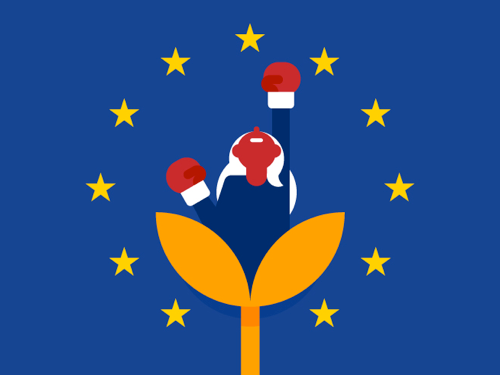Recruitment marketing: the future of talent acquisition?
16 sept 2019
5 min

That recruiting top talent depends for a large part on successful marketing is not a new idea; talent acquisition has always involved certain aspects of marketing and sales. But the role of marketing in recruitment was never structured, nor clearly-defined. This is changing, however, at lightning-speed.
The talent acquisition industry is currently experiencing the rapid fusion of marketing and recruiting.
To improve candidate engagement and set apart their employer brand on the job market, recruiters are increasingly using marketing tactics. Whereas recruiters have traditionally been wedged in-between marketing and HR, the talent acquisition industry is currently experiencing the rapid fusion of marketing and recruiting into a hybrid discipline: ‘recruitment marketing’.
In one sentence, recruitment marketing (RM) can be defined as a profound shift in the way companies engage and hire top talent. This means changing the way companies:
- Search and identify top talent
- Build and advertise their employer brand to selected audiences
- Nurture relationships with potential candidates once they have been identified
Source: Lighthouse Research and Advisory’s Recruitment Marketing Technology & Services (2016): Navigating the Vendor Landscape
Companies are prone to suffer from poor employer branding and high turnover rates.
In the traditional hiring model, when a new position opens up, HR posts the job opening and selects a handful of applicants who meet the basic requirements. Yet, given the increasing speed and frequency of disruptions in the (digital) economy, this ‘source-hire-repeat’ model is proving ineffective and outdated. It often results in a lengthy selection process, poor-quality candidates, and an inability to plan and budget ahead. What’s more, companies are prone to suffer from poor employer branding and high turnover rates, since candidates have higher expectations and competition over top talent is fiercer than ever.
Faced by these trends, companies across the globe are quickly realizing that developing a deeper understanding of digital marketing principles- and adapting these principles for use in their talent acquisition efforts - goes a long way in attracting and keeping top talent. Whereas traditional (‘reactionary’) recruiting has largely focused on filling specific job positions after the need arises, the most effective hiring practices today focus on implementing continuous marketing methods and creating the so-called ‘talent pipeline’, an ongoing pool of talent that is readily available to fill positions at all levels in the company.
Employee stories are the most important recruiting content you can create.
Employee testimonials, for instance, are a simple yet powerful way to draw potential candidates to the company. According to Loru Sylvia, founder of Rally Recruitment Marketing, an online forum dedicated to the latest RM insights, “employee stories are the most important recruiting content you can create.” With the advent of social media,video testimonialsare proving to be greatly effective, with companies like Alliander even going so far as to create interactive VR videos to recruit candidates.
A different approach is to focus on the data that drives the talent acquisition process. Companies like USG People have started hiring growth hackers to measure the activities needed to effectively recruit candidates. These growth hackers essentially play the role of innovator, marketer and explorer. They are responsible for the acquisition and activation of candidates on the basis of data analysis gathered from social media, marketing automation, search advertising, lead scoring, lead nurturing and data analysis.
Recruiting change from its current model - based on human decisions driven by intuition - toward a data-driven logic.
Yet, as the push to include more marketing and data analysis gains momentum among recruiters, the need for technological solutions has becomes ever more pressing.In a recent article, HR and recruiting expert John Sullivan recently declared 2017 to be “the year of the algorithm”, stating that recruiting will in the foreseeable future change from its current model - based on human decisions driven by intuition - toward a data-driven logic.
Indeed, all signs point towards the fact that, in the near future, data will be key. Companies are increasingly reaping the benefits from predictive modeling and data analytics. It should come as no surprise, then, that the same technology used by modern advertisers like Google and Facebook to target ads to customers by analyzing user data is now also seeping into recruitment.
Source: Lighthouse Research and Advisory’s Recruitment Marketing Technology & Services (2016): Navigating the Vendor Landscape
At the same time, however, a surprising amount of companies do not keep track of talent attraction and engagement metrics, such as campaign click-through rates and conversion rates. In fact, 51% of the companies questioned in one recent study indicated they still manually gather and analyse performance data, with 37% doing this within individual systems, tools, and/or service providers.
Source: Lighthouse Research and Advisory’s Recruitment Marketing Technology & Services (2016): Navigating the Vendor Landscape
These figures point to the fact that, in many instances, recruiting is still an educated guess. Choosing which human capital management solution to focus on is often a shot in the dark, despite the fact that the technology to recruit more effectively already exists and is evolving at a fast pace.
The onboarding of hires means communicating awareness and company culture to the applicant to facilitate a smooth onboarding process.
The are three fundamental parts to a recruiting framework. The first is candidate relationship management, which consists of sending messages and campaigns. Secondly, there is the need to track an applicant through the job application process. Third, there is the onboarding of hires, which is more than just filling a vacancy; done properly, it means communicating awareness and company culture to the applicant to facilitate a smooth onboarding process.
Yet, from the vast array of technologies that have been developed to match these three core necessities, a new challenge has emerged: the need for oversight. That’s where the Recruitment Management Platform (RMP) comes into play.
In essence, the RMP is a centralized control system through which talent attraction and engagement can be managed and whose function it is to centralize the operations of all marketing campaigns, providing easily trackable and measurable results along the way. In other words, it is a hub of tools and processes through which companies can manage all their recruitment channels and campaigns.
In its most complete form, the RM platform enables companies to gain insight and control over the following activities:
- Analytics & metrics: tracking every channel in the candidate journey all in one dashboard
- CRM (candidate relationship management): improving relationships with an existing database to eventually convert them into applicants
- Career site: creating a personalized career site that converts visitors into leads and job seekers into job applicants
- Job marketing: insights into metrics about which ads lead to quality hires to better manage distribution of ad budget
- Mobile recruiting: creating a smooth candidate experience across mobile devicesEmployee referrals: increasing quality referrals by tracking the effectiveness of sources
- Talent network: building stronger ‘talent pipelines’ to source from to proactively hire ‘ahead of the curve’
- Web sourcing: sourcing from anywhere on the web to find the right candidates faster
- SEO: search-optimized landing pages and job descriptions to help candidates find jobs and understand the employer brand
- Email marketing: engaging with the community through personalized email campaigns
- Automation: continuously marketing the employer brand and obtaining leads through automated workflows
When combined, these different channels make up a powerful recruitment machine that can have a massive impact. Recruitment marketing can save time, cut costs and, most importantly, attract better-suited candidates to specific job openings by increasing engagement and retention rates.
Including more marketing pushes recruiters to better define and communicate their employer brand.
The need to include more marketing pushes recruiters to better define and communicate their employer brand, which in turn leads to fuller and better talent pipelines. The RM platform achieves this goal of converting more talent to actual hires, and doing it faster and cheaper than ever before. With its focus on data-driven marketing, personalized targeting and engaging with prospective employees on a more direct and personal level, it combines all the elements that make a successful recruitment strategy possible. And, like many technologies that are increasingly relying on AI, the RM platform has raised questions about privacy and the ethics of letting a machine decide who is a suitable candidate. It has caused a split within the field of recruiting between those who interpret the data provided by the RM platform merely as useful information, leaving the ultimate decision in human hands, and those who increasingly leave their decision-making power in the hands of automation.
Either way, all signs indicate that recruitment marketing is here to stay. And, beyond the technological solutions of the RM platform, recruitment marketing as an emerging discipline is bound to forever transform the mindset and approach taken by traditional recruiters.
Follow Welcome to the Jungle on Facebook on LinkedIn and on Instagram and subscribe to our newsletter to get our latest articles every day!

Más inspiración: Marca empleadora

Is cultural add the new cultural fit?
A growing number of companies are swapping the question “What’s a good fit?” for “What’s missing?”
28 jun 2023

How to make your Glassdoor page an asset
50 million unique visitors flock to the Glassdoor social platform, making it the second most popular job site in the United States.
23 feb 2021

How blockchain could transform the core of HR
Accelerate fundamental HR processes, secure payroll, verify candidate's informations ... what blockchain brings to HR.
12 ago 2019

The American Dream in Europe?
This study highlights a global reflection on the new challenges of the entrepreneurial culture in France and the ecosystem that accompanies it.
09 ago 2019

Do Androids dream of stealing our jobs?
47% of current US occupations are at high risk of being replaced by machines. This revives a timeless debate that has pervaded recent history.
22 jul 2019

¿Estáis orgullosos de vuestra cultura empresarial?
Dadle la visibilidad que merece.
Más información sobre nuestras soluciones